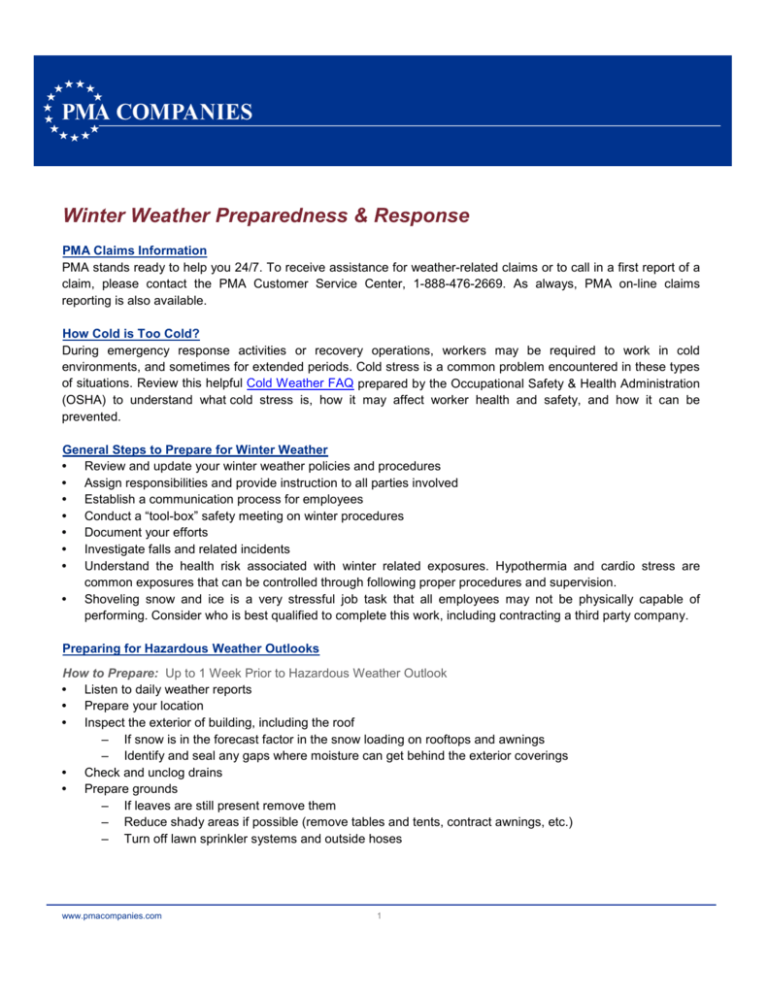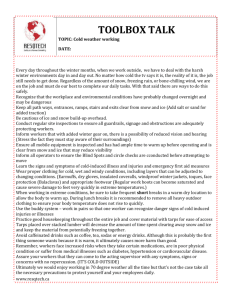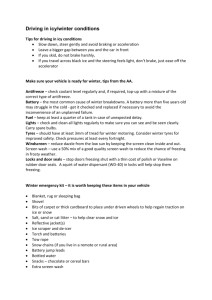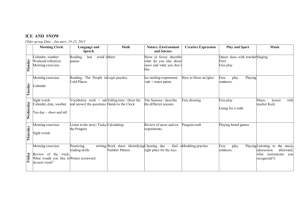
Winter Weather Preparedness & Response
PMA Claims Information
PMA stands ready to help you 24/7. To receive assistance for weather-related claims or to call in a first report of a
claim, please contact the PMA Customer Service Center, 1-888-476-2669. As always, PMA on-line claims
reporting is also available.
How Cold is Too Cold?
During emergency response activities or recovery operations, workers may be required to work in cold
environments, and sometimes for extended periods. Cold stress is a common problem encountered in these types
of situations. Review this helpful Cold Weather FAQ prepared by the Occupational Safety & Health Administration
(OSHA) to understand what cold stress is, how it may affect worker health and safety, and how it can be
prevented.
General Steps to Prepare for Winter Weather
• Review and update your winter weather policies and procedures
• Assign responsibilities and provide instruction to all parties involved
• Establish a communication process for employees
• Conduct a “tool-box” safety meeting on winter procedures
• Document your efforts
• Investigate falls and related incidents
• Understand the health risk associated with winter related exposures. Hypothermia and cardio stress are
common exposures that can be controlled through following proper procedures and supervision.
• Shoveling snow and ice is a very stressful job task that all employees may not be physically capable of
performing. Consider who is best qualified to complete this work, including contracting a third party company.
Preparing for Hazardous Weather Outlooks
How to Prepare: Up to 1 Week Prior to Hazardous Weather Outlook
• Listen to daily weather reports
• Prepare your location
• Inspect the exterior of building, including the roof
‒ If snow is in the forecast factor in the snow loading on rooftops and awnings
‒ Identify and seal any gaps where moisture can get behind the exterior coverings
• Check and unclog drains
• Prepare grounds
‒ If leaves are still present remove them
‒ Reduce shady areas if possible (remove tables and tents, contract awnings, etc.)
‒ Turn off lawn sprinkler systems and outside hoses
www.pmacompanies.com
1
•
•
•
•
•
•
•
Inventory snow removal equipment and accessories
‒ Ice melt
‒ Shovels
‒ Sand
‒ Mobile equipment to remove ice
‒ Squeegees
‒ Brooms
‒ Blowers
Remember to document your inspection of all equipment
Employees under the age of 18 are not permitted to operate power equipment
Inventory items needed to house staff
For employees who may be traveling in motor vehicles, assure each vehicle is equipped with ice melt, sand,
shovel, blankets, and ice scrapers
‒ Inspect all vehicles to assure they are in proper working order and prepared for winter weather
operation
‒ Provide each vehicle with mobile device chargers
Establish and communicate call-in number for staff/employees
If using a snow removal company, contact them to assure they are ready for your needs
Winter Storm Watch: 24-36 Hours Before Hazardous Weather
• Determine who will be taking the lead for snow removal
• Purchase items needed but not on hand
• Review stockpile of material
• Continue to repair areas that puddle
• Continue to check leaves, hoses, facilities, etc.
• Gather supplies needed to house and feed faculty during the storm
• Begin cordoning off areas that may form ice
Winter Storm Warning: 0-12 Hours Before Hazardous Weather
• Implement final preparation
• Apply first de-icing
During the Hazardous Weather
• Take precautions as necessary
• If possible, begin shoveling main walkways/parking lots to reduce snow accumulation
Post Hazardous Weather
• Begin removing snow according to winter weather plan
‒ Blowers
‒ Shovels
‒ Mechanical equipment
• Once initial shoveling is completed, apply de-icer
‒ Pile snow/ice in banks
‒ Assure melt does not present more problems
‒ Pile near drains if possible
‒ Cordon off any shady area or area thick with ice
www.pmacompanies.com
2
Once the Snow and Ice Begins to Melt
• Remove ice/snow as it melts
• Brush or squeegee sidewalks and parking lots where water accumulates
• Clear maintain entrances to buildings
• If temperature dips below 32 degrees or pavement temperature has not risen to 32 degrees, reapply de-icer
just before sundown
Preparing Your Workers
• Define policy on how closures and early dismissals will be communicated
‒ Who’s calling whom?
‒ Include e-mail addresses and mobile phone numbers
‒ Establish call-in number for office and facility/plant closings
• HR: How will closings and early dismissals be reflected in hourly pay?
Protecting Workers and Preventing Slips & Falls
• If they need to work outdoors, workers should wear proper outerwear and footwear
‒ Layer clothing
‒ Avoid cotton fabrics
‒ Cover your skin
• Manage breaks to avoid overexposure and common cold weather hazards such as hypothermia and cardio
stress from shoveling snow and ice
• Place weather mats at all entrances for people visiting your facilities
‒ The length of the mat needs to capture as much moisture off shoes as possible
Follow the three-step guideline
Keep porous mats outside so they absorb snow/ice from footwear
Use relatively rough mats in foyer areas
Use walk-off mats to remove moisture
Change mats once saturated
‒ Place shoe brushes at entrances to remove as much snow and ice as possible
‒ Where applicable, provide space and facilities to allow employees to change footwear upon entering
the building
‒ Maintain floors and post caution signs where slip and fall conditions prevail
For additional information, please contact:
PMA Companies
380 Sentry Parkway
Blue Bell, PA 19422-0754
TF: 800.222.2749
www.pmacompanies.com
© 2015 OLD REPUBLIC GENERAL INSURANCE GROUP
All Rights Reserved
Edition: 10/2015
www.pmacompanies.com
3








